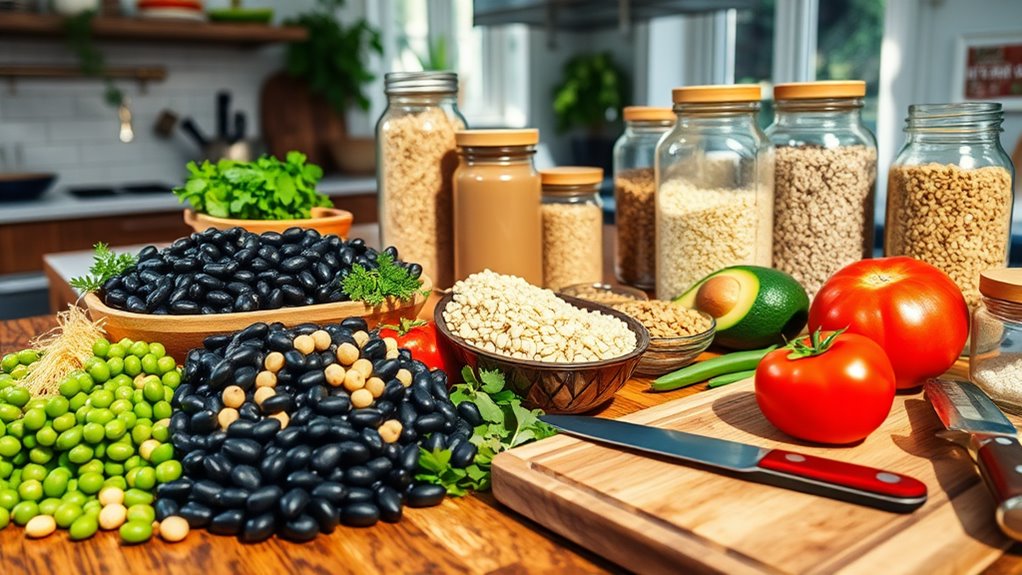To construct a high-protein vegan meal plan, integrate a variety of protein-rich foods like lentils, chickpeas, tofu, and quinoa. Include nuts and seeds for healthy fats and extra protein. Make certain to balance your meals with essential nutrients like iron, calcium, and omega-3 fatty acids. Meal planning strategies such as batch cooking and prepping snacks can save you time and guarantee you meet your protein goals. Formulate meals like quinoa salads or lentil stew for tasty options. By implementing these strategies, you'll set yourself up for success; there's more to explore to enhance your plan further.
Key Takeaways
- Incorporate diverse protein sources like legumes, tofu, nuts, and whole grains to ensure adequate protein intake.
- Include essential nutrients such as iron, omega-3 fatty acids, and calcium through fortified foods and diverse plant options.
- Plan meals weekly, utilizing a template to visualize meals and streamline grocery shopping.
- Batch cook proteins and pre-cut vegetables for quick meal assembly and easy snacking.
- Establish a support system for motivation, track progress, and adjust portion sizes based on individual goals.
Understanding Protein Sources
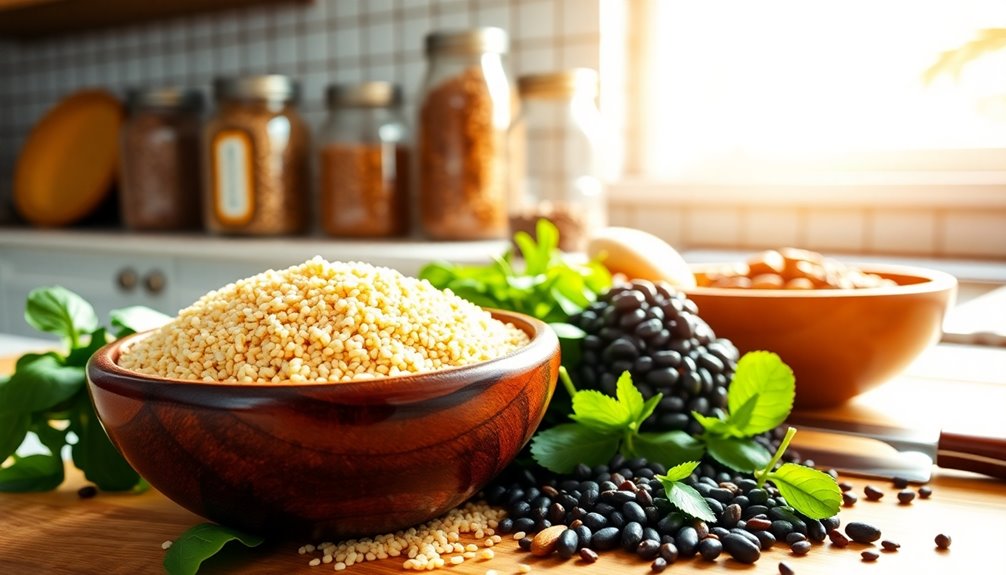
When constructing a high-protein vegan meal plan, understanding the variety of protein sources available to you is essential. Plant-based proteins can be diverse and delicious, helping you meet your protein needs while enjoying a flavorful diet. The key is to incorporate a mix of different sources to make sure you're getting all the essential amino acids your body needs.
Start with legumes, such as lentils, chickpeas, and black beans. They're not only packed with protein but also rich in fiber, which supports digestive health.
Tofu and tempeh are excellent choices too; they offer a significant protein punch and can be easily incorporated into stir-fries, salads, or sandwiches.
Don't overlook whole grains like quinoa, farro, and brown rice, which provide both protein and essential nutrients.
Nuts and seeds, such as almonds, chia seeds, and hemp seeds, are great additions. They not only add protein but also healthy fats, making your meals more satisfying.
Incorporating plant-based protein powders into smoothies or oatmeal can also increase your intake without much effort.
Consider the unique protein requirements for your lifestyle. If you're active, you may need more protein than someone with a sedentary routine. Tracking your intake can help you make sure you're meeting your goals. Additionally, a well-planned plant-based diet can aid in weight loss while still providing sufficient protein for your needs.
Essential Nutrients to Consider
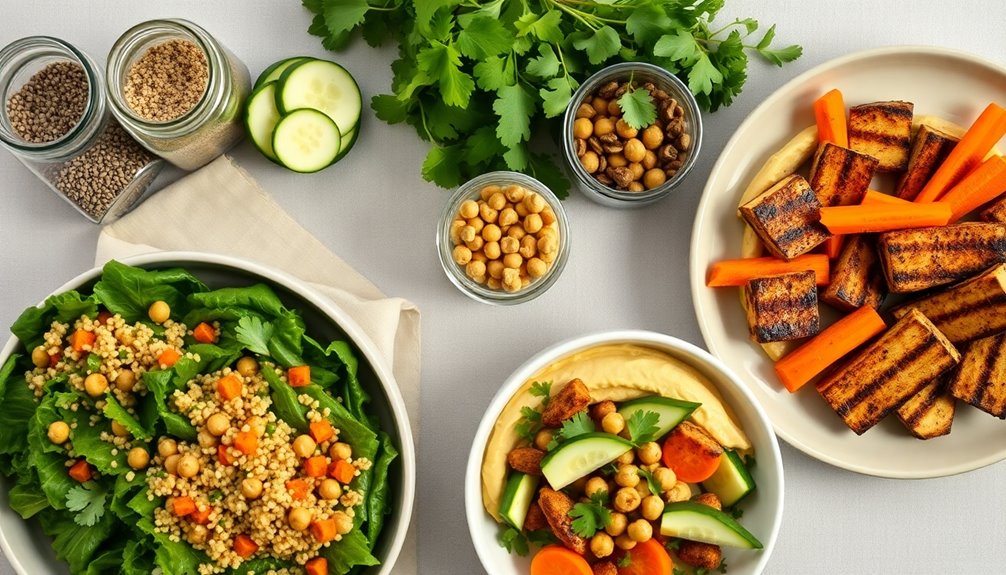
In crafting a high-protein vegan meal plan, it's important to pay attention to essential nutrients beyond just protein. While meeting your protein requirements is pivotal for muscle repair and overall health, you'll also want to make sure you're getting a balanced intake of other essential nutrients.
First up, consider iron. Many plant-based sources, like lentils, chickpeas, and spinach, are great for iron, but remember that non-heme iron from plants is less easily absorbed than heme iron from animal products. Pairing these foods with vitamin C-rich items, like bell peppers or citrus fruits, can enhance absorption.
Next, don't overlook omega-3 fatty acids. These healthy fats are key for heart health and brain function. You can find them in flaxseeds, chia seeds, and walnuts. If you're not consuming these regularly, consider a vegan omega-3 supplement derived from algae.
Calcium is another nutrient to keep in mind, especially for bone health. Look for fortified plant-based milks, tofu, and leafy greens like kale and bok choy as your calcium sources.
Lastly, B12 is essential for vegans, as it's typically found in animal products. Make sure to include fortified foods or consider a B12 supplement to avoid deficiencies. Additionally, be aware that traditional bread's health impacts can detract from your overall nutrient intake, so choosing grain-free options may be beneficial.
Meal Planning Strategies
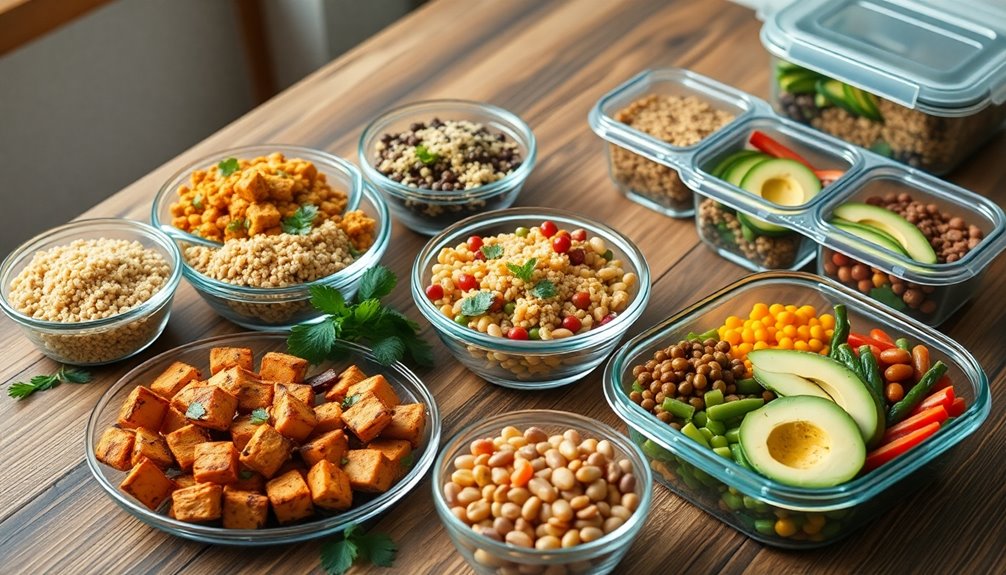
To effectively create a high-protein vegan meal plan, consider establishing a weekly framework that simplifies your grocery shopping and meal preparation. Start with a meal planning template to help you visualize your week. This can save you time and make sure you've got all the ingredients on hand. Focus on high-protein staples like lentils, quinoa, chickpeas, and tofu. Incorporating ingredient swaps can also enhance variety without sacrificing nutrition. For instance, if you usually use rice, try quinoa for a protein boost. Plan your meals around these staples and keep portion control in mind to help manage your intake and avoid waste. Additionally, using whole food sources of protein can further optimize your meal plan and reduce reliance on processed items.
Here's a simple meal planning table to guide you:
| Meal Type | High-Protein Choices |
|---|---|
| Breakfast | Chia seed pudding with almond milk |
| Lunch | Quinoa salad with black beans and veggies |
| Dinner | Stir-fried tofu with broccoli and brown rice
Sample Meal Plan Ideas
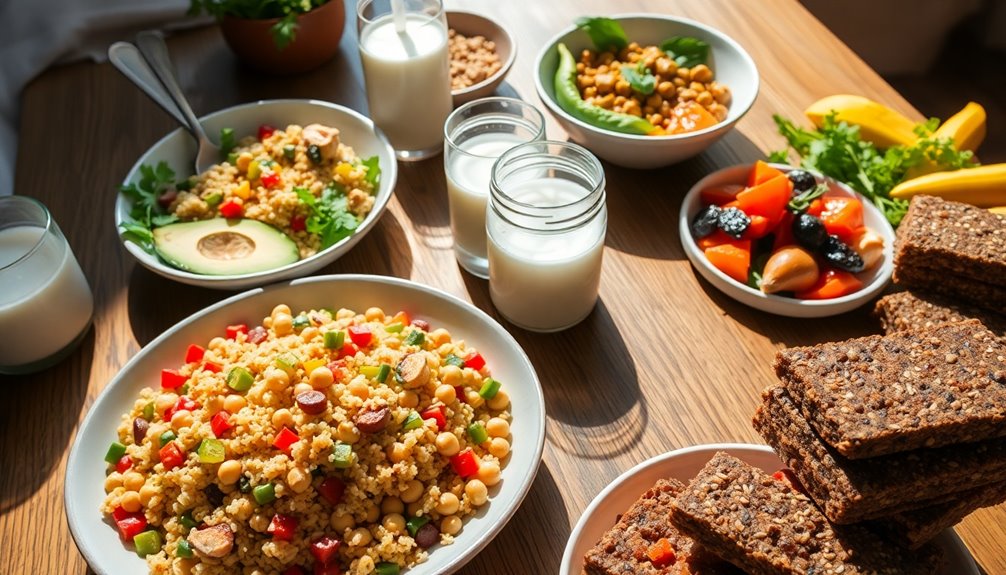
Creating a high-protein vegan meal plan becomes much easier with some concrete examples to guide your choices. Start your day with a hearty breakfast of overnight oats made with almond milk, chia seeds, and topped with sliced almonds and berries. This combination offers a solid protein boost while providing essential nutrients.
For lunch, consider a quinoa salad mixed with black beans, corn, diced peppers, and a squeeze of lime. Quinoa is a fantastic source of plant-based protein, and the black beans add even more. Pair this with a side of hummus and carrot sticks for some delicious protein-rich snacks.
When it's time for dinner, opt for a stir-fry featuring tofu or tempeh, loaded with your favorite vegetables like broccoli, bell peppers, and snap peas. Serve it over brown rice or whole grain noodles for a filling meal. Don't forget to sprinkle some sesame seeds on top for added crunch and protein!
Throughout the day, keep protein-rich snacks on hand, such as roasted chickpeas, edamame, or a handful of mixed nuts. These aren't only satisfying but also help you meet your protein needs. Additionally, incorporating a variety of legumes and whole grains can significantly contribute to reducing greenhouse gas emissions while maintaining a balanced diet.
Delicious High-Protein Recipes
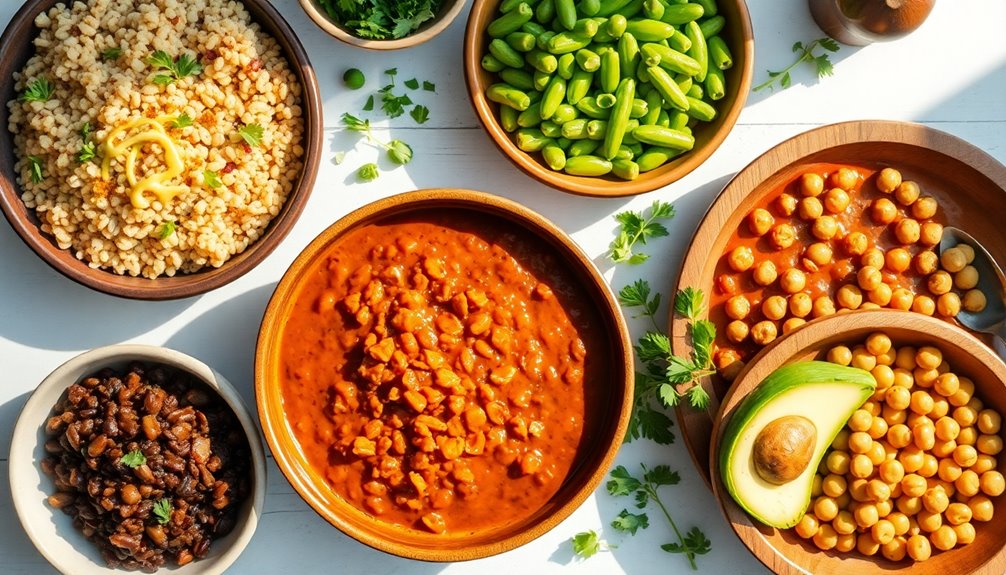
When you're looking to boost your protein intake on a vegan diet, having a collection of delicious recipes at your fingertips can make all the difference. You'll find that incorporating high-protein ingredients into your meals not only satisfies your hunger but also supports your fitness goals.
Start your day with a protein-packed smoothie. Blend your favorite fruits with a scoop of plant-based protein powder, some spinach, and a tablespoon of nut butter for a creamy, satisfying breakfast.
If you're craving a snack, consider chickpea salad on whole-grain bread or hummus paired with fresh veggies. Both options deliver protein while keeping you energized.
For lunch or dinner, try a quinoa and black bean bowl topped with avocado and salsa. Quinoa is a complete protein, and the black beans add even more protein while providing fiber. Another option is a lentil stew, loaded with vegetables and spices that can warm you up on a chilly day.
Don't forget about protein-packed snacks! Roasted edamame or spiced chickpeas can be great for munching. You can also whip up some energy balls using oats, nut butter, and plant-based protein powder for a quick post-workout treat. The versatility of these meals makes it easy to incorporate smoothie recipes that can help with weight loss and health improvements.
With these recipes, you won't just meet your protein needs, but you'll also enjoy every bite. Remember, a well-rounded vegan meal plan isn't only about nutrition; it's about making meals that bring joy and connection to your daily life.
Tips for Staying Motivated
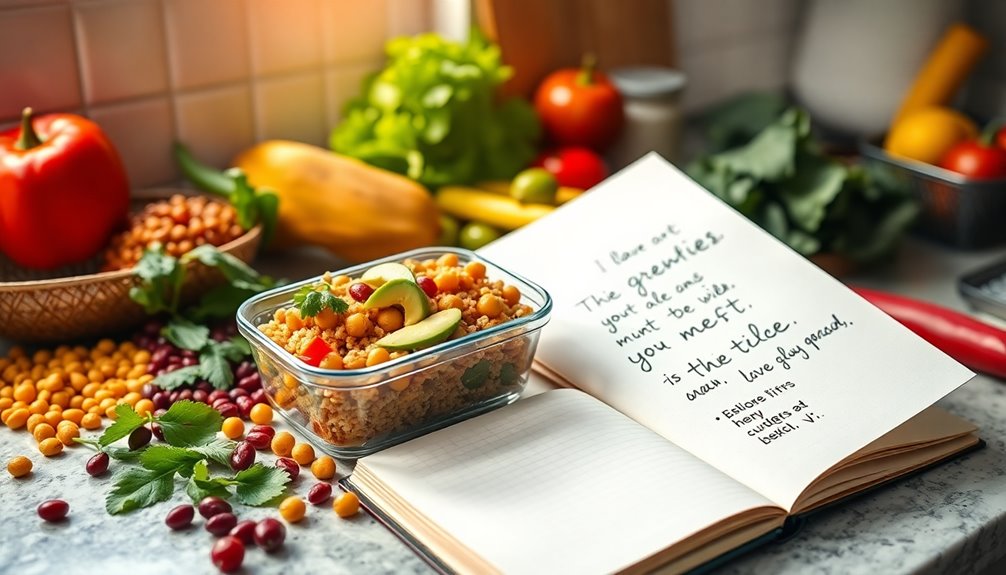
Staying motivated on your high-protein vegan journey can sometimes feel challenging, but setting clear, achievable goals can make a significant difference. Start by breaking your larger objectives into smaller, manageable steps. Whether it's trying a new recipe each week or increasing your protein intake gradually, these goals can keep you focused and driven.
Accountability plays a pivotal role in maintaining your motivation. Share your goals with friends or family, or consider finding a buddy who's also interested in veganism. Regular check-ins can provide encouragement and keep you on track. You're more likely to stick to your plan when someone's cheering you on.
Finding support within a community can also enhance your motivation. Look for local vegan groups or online forums where you can connect with like-minded individuals. Sharing experiences, recipes, and tips can foster a sense of belonging and inspire you to stay committed to your high-protein meal plan.
Don't forget to celebrate your achievements, no matter how small they seem. Acknowledging your progress can boost your confidence and keep you motivated. Consider keeping a journal to document your journey, reflecting on what works for you and what doesn't. Additionally, joining an online support community can provide valuable resources and progress tracking tools to help you stay on course.
Frequently Asked Questions
Can I Get Enough Protein From a Vegan Diet Alone?
Yes, you can absolutely get enough protein from a vegan diet alone! By incorporating various plant-based sources like legumes, nuts, seeds, and whole grains, you can create protein-rich meals that meet your nutritional needs.
Foods such as lentils, chickpeas, quinoa, and tofu are excellent options. With a little planning, you can enjoy diverse and satisfying meals that provide ample protein while supporting your health and lifestyle.
You're not alone in this journey!
How Do I Track My Protein Intake Effectively?
To track your protein intake effectively, start by using protein tracking tools like apps or food diaries. They help you log meals and monitor protein sources. Incorporate protein-rich snacks, such as nuts or legumes, into your diet.
Remember, it's not just about quantity; consider protein absorption too, as some sources are more easily utilized by your body.
Staying consistent with tracking will help you meet your goals and feel connected to your health journey.
Are Protein Supplements Necessary for Vegans?
You don't necessarily need protein supplements as a vegan, but they can help if you're struggling to meet your protein needs. Focus on diverse protein sources like lentils, chickpeas, quinoa, and nuts to achieve nutritional balance. Whole foods often provide additional nutrients that supplements lack.
If you keep an eye on your intake and guarantee variety, you can thrive without relying solely on supplements. It's all about finding what works best for you!
What Are Common Protein Deficiencies in Vegan Diets?
Imagine you're a vegan athlete, training hard but struggling with energy. You might find yourself deficient in protein sources like legumes or quinoa, which are vital for muscle repair. This deficiency can affect nutrient absorption, leaving you fatigued and underperforming.
Research shows that without a balanced intake of diverse plant proteins, you risk missing essential amino acids. Prioritize variety in your meals to support your health and athletic goals effectively.
How Can I Increase Protein in Snacks Easily?
To easily increase protein in your snacks, focus on protein-rich snacks that incorporate plant-based protein sources. Think about munching on roasted chickpeas, edamame, or a handful of nuts and seeds.
You can also whip up a smoothie with protein powder, spinach, and nut butter for a delicious boost. Try adding hummus with veggies or whole-grain toast topped with avocado and nutritional yeast.
These options not only satisfy but also keep you feeling energized!
Conclusion
As you navigate the garden of plant-based eating, remember that every seed of knowledge you plant grows into a vibrant meal plan rich in protein. By understanding diverse protein sources and carefully nurturing your meals with essential nutrients, you'll cultivate not just strength but also a lasting love for your food. Embrace the journey, stay motivated, and let your creativity flourish. With each delicious recipe, you're crafting a nourishing landscape that fuels both body and spirit.

